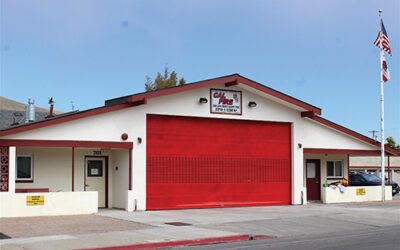San Luis Obispo County will apply for federal COVID relief funds to cover impacts to the County’s airports caused by the coronavirus pandemic, even as a contract was awarded for a $13 million overhaul of the main airport runway.
County Supervisors were asked to allow the airports to apply for a $2.26 million grant for the SLO County Regional Airport in SLO from the “Coronavirus Response and Relief Supplemental Appropriation Act” (CRRSA) that was part of President Trump’s “Consolidated Appropriations Act, 2021,” a COVID relief bill he signed Dec. 27, 2020.
That funding act included some $2 billion “in economic relief to airports to prevent, prepare for, and respond to the COVID-19 pandemic, including relief from rent and minimum annual guarantees (MAG) for eligible airport concessions at primary airports,” reads a report from Airports Director, Courtney Johnson.
This money would come through the Federal Aviation Administration.
She would also be applying for a $9,000 CRRSA grant for the Oceano Airport and a $57,000 grant from the FAA for the County Regional Airport.
There aren’t many limits on how this money can be spent. “An airport sponsor may use these funds for costs related to operations, personnel, cleaning, sanitization, janitorial services, combating the spread of pathogens at the airport, and debt service payments,” reads a FAQ page accompanying the staff report.
About the only thing an airport can’t do with the money is bank it or set it aside for a future use. “FAA would not be able to ensure a potential future use is a use consistent with CRRSA requirements.”
Johnson said expenditures that are eligible for Operations and Maintenance funding include:
- Any purpose for which airport revenues may lawfully be used;
- Generally available for expenditures allowed by the FAA’s Policy and Procedures Concerning the Use of Airport Revenue (Revenue-Use Policy);
- Reimbursement requests for operating expenses may not include activities prior to Jan. 20, 2020; and,
- Period of Performance (POP): Four (4) years. Funds not expended within the 4-year POP are subject to recovery by the FAA.
If they get the money it would, “minimize the severe economic disruption caused by the COVID-19 public health emergency, ensuring the long-term viability of the airport, improving the safety of operations and contributing to a safe and livable community.”
In other recent airport developments, Supervisors awarded a $12.62 million contract to Watsonville-based, Granite Const., to completely rehabilitate the main runway at the County Regional Airport.
Supervisors also approved a consulting contract with Mead & Hunt, a nationwide engineering firm with offices across the U.S., with the closest office to SLO County in Ontario, Calif. Mean & Hunt are already under contract as general consultants and this latest extension is for $772,000 and includes project management duties.
The total contracts for the runway job are over $13.58 million.
Granite Const.’s contract represents the “Guaranteed Maximum Price” for the construction and post-construction phases of the project. It’s being done under a so-called, “Construction Manager at Risk” or CMAR method of project delivery, as opposed to a “design-bid-build” or “design-build” method of delivery.
A CMAR method, “entails a commitment by the construction manager to deliver a project within a ‘Guaranteed Maximum Price,’ in most cases,” according to an online definition of the term.
Supervisors in November 2018 authorized the airport administration to seek FAA “Airport Improvement Program” (AIP) grants to fund several projects at the airport.
“Rehabilitation of the runway,” Johnson’s report said, “also includes the rehabilitation of the runway lighting system including runway lights, lighted directional signs, power conductors and conduits,” as well as the runway surface itself with milling (grinding down) of the old pavement and overlaying of new pavement.
No matter how extensive the work is it will disrupt air traffic at the airport. The SLO County Airport “has only one runway available to commercial aircraft, disruption to commercial service will occur during construction of this project,” Johnson said. “Therefore, an imperative need of the project is to minimize the disruption window as much as possible and CMAR offered that opportunity by getting the contractor onboard early to work with the project designer on logistical solutions such as phasing, staging, material procurement, and establishment of temporary and alternate vehicle and aircraft maneuvering routes during construction as the design was being finalized.”


